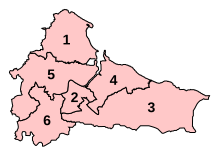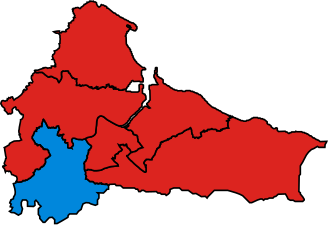List of parliamentary constituencies in Cleveland
Cleveland was abolished in 1996 both as a county council and a non-metropolitan county, being succeeded by the unitary authorities of Hartlepool, Middlesbrough, Redcar and Cleveland, and Stockton-on-Tees. The constituency boundaries used up to the 2005 United Kingdom general election were drawn up when the county still existed. For the review which came into effect for the 2010 general election, the four authorities were considered separately, with Middlesbrough and Redcar and Cleveland being combined.[1]
For the 2023 Periodic Review of Westminster constituencies, coming into effect for the 2024 United Kingdom general election, the Boundary Commission for England considered the area comprising the Tees Valley Combined Authority, which also includes the unitary authority of Darlington, as a sub-region of the North East Region.[2] For the purposes of this series of articles, the constituency of Darlington continues to be included in List of parliamentary constituencies in County Durham.
The area is divided into 6 parliamentary constituencies – 3 borough constituencies and 3 county constituencies.
Constituencies
[edit]† Conservative ‡ Labour ¤ Reform UK
| Constituency[nb 1] | Electorate | Majority[nb 2] | Member of Parliament | Nearest opposition | Electoral wards[3] | Map | ||
|---|---|---|---|---|---|---|---|---|
| Hartlepool BC | 71,437 | 7,698 | Jonathan Brash‡ | Amanda Napper¤ | Hartlepool Borough Council: Burn Valley, De Bruce, Fens and Greatham, Foggy Furze, Hart, Headland and Harbour, Manor House, Rossmere, Rural West, Seaton, Throston, Victoria. |  | ||
| Middlesbrough and Thornaby East BC | 75,123 | 9,192 | Andy McDonald‡ | Patrick Seargeant¤ | Middlesbrough Borough Council: Acklam, Ayresome, Berwick Hills and Pallister, Brambles and Thorntree, Central, Kader, Linthorpe, Longlands and Beechwood, Newport, North Ormesby, Park, Trimdon. Stockton-on-Tees Borough Council: Mandale and Victoria, Stainsby Hill. |  | ||
| Middlesbrough South and East Cleveland CC | 70,328 | 214 | Luke Myer‡ | Simon Clarke† | Middlesbrough Borough Council: Coulby Newham, Hemlington, Ladgate, Marton East, Marton West, Nunthorpe, Park End and Beckfield, Stainton and Thornton. Redcar and Cleveland Borough Council: Belmont, Brotton, Guisborough, Hutton, Lockwood, Loftus, Skelton East, Skelton West. |  | ||
| Redcar BC | 70,241 | 3,323 | Anna Turley‡ | Jacob Young† | Redcar and Cleveland Borough Council: Coatham, Dormanstown, Eston, Grangetown, Kirkleatham, Longbeck, Newcomen, Normanby, Ormesby, St Germain's, Saltburn, South Bank, Teesville, West Dyke, Wheatlands, Zetland. |  | ||
| Stockton North CC | 70,242 | 7,939 | Chris McDonald‡ | John McDermottroe¤ | Stockton-on-Tees Borough Council: Billingham Central, Billingham East, Billingham North, Billingham South, Billingham West, Hardwick and Salters Lane, Newtown, Northern Parishes, Norton North, Norton South, Norton West, Parkfield and Oxbridge, Roseworth, Stockton Town Centre. |  | ||
| Stockton West CC | 69,664 | 2,139 | Matt Vickers† | Joe Dancey‡ | Darlington Borough Council: Hurworth, Sadberge and Middleton St. George. Stockton-on-Tees Borough Council: Bishopsgarth and Elm Tree, Eaglescliffe, Fairfield, Grangefield, Hartburn, Ingleby Barwick East, Ingleby Barwick West, Village, Western Parishes, Yarm. |  | ||
Boundary changes
[edit]2024
[edit]See 2023 Periodic Review of Westminster constituencies for further details.
| Name (2010-2024) | Boundaries 2010–2024 | Name (2024-present) | Boundaries (2024-present) |
|---|---|---|---|
 |
 |
For the 2023 Periodic Review of Westminster constituencies, which redrew the constituency map ahead of the 2024 United Kingdom general election, the Boundary Commission for England opted to combine the four unitary authorities which make up the former county of Cleveland with the Borough of Darlington (previously considered with County Durham) to form a Tees Valley sub-division of the North East region. The commission also opted to rename Middlesbrough to Middlesbrough and Thornaby East, and rename Stockton South to Stockton West.[4][2]
The following seats resulted from the boundary review:
Containing electoral wards in Hartlepool
Containing electoral wards in Middlesbrough
Containing electoral wards in Redcar and Cleveland
- Middlesbrough South and East Cleveland (part)
- Redcar
Containing electoral wards in Stockton-on-Tees
- Middlesbrough and Thornaby East (part)
- Stockton North
- Stockton West (part also in Darlington)
2010
[edit]Under the Fifth Periodic Review of Westminster constituencies, the Boundary Commission for England decided to retain Cleveland's constituencies for the 2010 election, making minor changes to realign constituency boundaries with the boundaries of existing local government wards and to reduce the electoral disparity between Stockton North and Stockton South.
| Name | Boundaries 1997-2010 | Boundaries 2010–2024 |
|---|---|---|
 |
 |
Results history
[edit]Primary data source: House of Commons research briefing - General election results from 1918 to 2019[5]
2019
[edit]The number of votes cast for each political party who fielded candidates in constituencies comprising Cleveland in the 2019 general election were as follows:
| Party | Votes | % | Change from 2017 | Seats | Change from 2017 |
|---|---|---|---|---|---|
| Conservative | 112,092 | 43.5% | 3 | ||
| Labour | 104,691 | 40.6% | 3 | ||
| Liberal Democrats | 10,452 | 4.1% | 0 | 0 | |
| Greens | 2,257 | 0.9% | 0 | 0 | |
| Brexit | 19,837 | 7.7% | new | 0 | 0 |
| Others | 8,465 | 3.2% | 0 | 0 | |
| Total | 257,794 | 100.0 | 6 |
Percentage votes
[edit]| Election year | 1983 | 1987 | 1992 | 1997 | 2001 | 2005 | 2010 | 2015 | 2017 | 2019 |
|---|---|---|---|---|---|---|---|---|---|---|
| Conservative | 35.8 | 33.8 | 37.1 | 25.2 | 26.3 | 23.0 | 27.7 | 29.0 | 38.8 | 43.5 |
| Labour | 37.9 | 44.7 | 50.0 | 62.4 | 59.5 | 51.9 | 39.9 | 43.3 | 53.8 | 40.6 |
| Liberal Democrat1 | 26.2 | 20.9 | 12.8 | 9.8 | 12.4 | 19.3 | 21.4 | 5.3 | 2.6 | 4.1 |
| Green Party | - | * | * | * | * | * | - | 2.3 | 0.4 | 0.9 |
| UKIP | - | - | - | * | * | * | 4.3 | 17.9 | 4.2 | * |
| Brexit Party | - | - | - | - | - | - | - | - | - | 7.7 |
| Other | 0.1 | 0.6 | 0.2 | 2.6 | 1.8 | 5.8 | 6.7 | 2.2 | 0.2 | 3.2 |
11983 & 1987 - SDP-Liberal Alliance
* Included in Other
Seats
[edit]| Election year | 1983 | 1987 | 1992 | 1997 | 2001 | 2005 | 2010 | 2015 | 2017 | 2019 |
|---|---|---|---|---|---|---|---|---|---|---|
| Conservative | 1 | 2 | 2 | 0 | 0 | 0 | 1 | 1 | 1 | 3 |
| Labour | 4 | 4 | 4 | 6 | 6 | 6 | 4 | 5 | 5 | 3 |
| Liberal Democrat1 | 1 | 0 | 0 | 0 | 0 | 0 | 1 | 0 | 0 | 0 |
| Total | 6 | 6 | 6 | 6 | 6 | 6 | 6 | 6 | 6 | 6 |
11983 & 1987 - SDP-Liberal Alliance
Maps
[edit]1983 to 2019
[edit]-
1983
-
1987
-
1992
-
1997
-
2001
-
2005
-
2010
-
2015
-
2017
-
2019
2024 to present (including one cross-county constituency)
[edit]-
2024
Historical representation by party
[edit]1983 to 2010
[edit]Conservative Labour Social Democratic
| Constituency | 1983 | 1987 | 91 | 1992 | 1997 | 2001 | 04 | 2005 |
|---|---|---|---|---|---|---|---|---|
| Hartlepool | Leadbitter | Mandelson | Wright | |||||
| Langbaurgh / Middlesbrough S & E Cleveland ('97) | Holt | Kumar | Bates | Kumar | ||||
| Middlesbrough | Bell | |||||||
| Redcar | Tinn | Mowlam | Baird | |||||
| Stockton North | Cook | |||||||
| Stockton South | Wrigglesworth | Devlin | Taylor | |||||
2010 to present
[edit]Conservative Independent Labour Liberal Democrats
| Constituency | 2010 | 12 | 2015 | 2017 | 2019 | 21 | 23 | 24 | 2024 |
|---|---|---|---|---|---|---|---|---|---|
| Hartlepool | Wright | Hill | Mortimer | Brash | |||||
| Middlesbrough / Middlesbrough & Thornaby E ('24) | Bell | McDonald | → | → | |||||
| Middlesbrough South & East Cleveland | Blenkinsop | Clarke | Myer | ||||||
| Redcar | Swales | Turley | Young | Turley | |||||
| Stockton North | Cunningham | McDonald | |||||||
| Stockton South / Stockton West (2024)1 | Wharton | Williams | Vickers | ||||||
1also includes some areas in the Darlington area of County Durham
See also
[edit]- List of parliamentary constituencies in the North East (region)
- History of parliamentary constituencies and boundaries in Cleveland
Notes
[edit]References
[edit]- ^ "The Parliamentary Constituencies Order (England) 2007".
- ^ a b "The 2023 Review of Parliamentary Constituency Boundaries in England – Volume one: Report | Boundary Commission for England". boundarycommissionforengland.independent.gov.uk. paras 686-698. Retrieved 9 July 2023.
- ^ "The Parliamentary Constituencies Order 2023", legislation.gov.uk, The National Archives, SI 2023/1230, retrieved 13 July 2024
- ^ "Political boundaries across the North East could change - here's what it could mean for you". The Northern Echo. 8 November 2022. Retrieved 13 December 2022.
- ^ Watson, Christopher; Uberoi, Elise; Loft, Philip (17 April 2020). "General election results from 1918 to 2019". Retrieved 3 May 2020.








